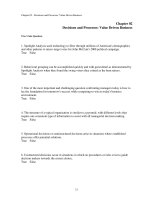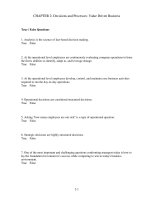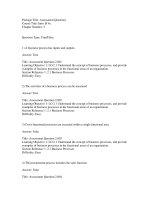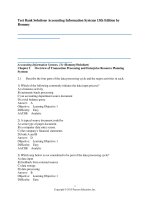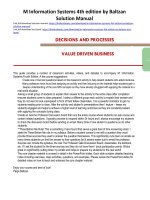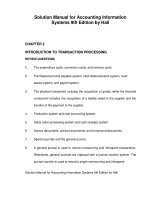M information systems 4th edition by baltzan test bank
Bạn đang xem bản rút gọn của tài liệu. Xem và tải ngay bản đầy đủ của tài liệu tại đây (1.04 MB, 165 trang )
M Information Systems 4th edition by Baltzan
Test Bank
Link full download test bank: />
Chapter 02 Decisions + Processes: Value Driven Business Answer Key
True / False Questions
1.
Analytics is the science of fact-based decision making.
TRUE
Analytics is the science of fact-based decision making.
Accessibility: Keyboard Navigation
Blooms: Remember
Difficulty: 1 Easy
Learning Objective: 02-01 Explain the importance of decision making for managers at each of the three primary organization
levels along with the associated decision characteristics.
Topic: Making Business Decisions
2.
At the operational level employees are continuously evaluating company operations to hone
the firm's abilities to identify, adapt to, and leverage change.
FALSE
At the managerial level employees are continuously evaluating company operations to hone
the firm's abilities to identify, adapt to, and leverage change.
Accessibility: Keyboard Navigation
Blooms: Remember
Difficulty: 1 Easy
Learning Objective: 02-01 Explain the importance of decision making for managers at each of the three primary organization
levels along with the associated decision characteristics.
Topic: Making Business Decisions
2-1
Copyright © 2018 McGraw-Hill Education. All rights reserved. No reproduction or distribution without the prior written consent of
McGraw-Hill Education.
3.
At the operational level employees are develop, control, and maintain core business activities
required to run the day-to-day operations.
TRUE
At the operational level employees are develop, control, and maintain core business activities
required to run the day-to-day operations.
Accessibility: Keyboard Navigation
Blooms: Remember
Difficulty: 1 Easy
Learning Objective: 02-01 Explain the importance of decision making for managers at each of the three primary organization
levels along with the associated decision characteristics
Topic: Making Business Decisions
4.
Operational decisions are considered structured decisions.
TRUE
Operational decisions are considered structured decisions.
Accessibility: Keyboard Navigation
Blooms: Remember
Difficulty: 1 Easy
Learning Objective: 02-01 Explain the importance of decision making for managers at each of the three primary organization
levels along with the associated decision characteristics.
Topic: Making Business Decisions
5.
Asking how many employees are out sick is a type of operational question.
TRUE
Asking how many employees are out sick is a type of operational question.
Accessibility: Keyboard Navigation
Blooms: Remember
Difficulty: 1 Easy
Learning Objective: 02-01 Explain the importance of decision making for managers at each of the three primary organization
levels along with the associated decision characteristics.
Topic: Making Business Decisions
2-2
Copyright © 2018 McGraw-Hill Education. All rights reserved. No reproduction or distribution without the prior written consent of
McGraw-Hill Education.
6.
Strategic decisions are highly structured decisions.
FALSE
Strategic decisions are highly unstructured decisions.
Accessibility: Keyboard Navigation
Blooms: Remember
Difficulty: 1 Easy
Learning Objective: 02-01 Explain the importance of decision making for managers at each of the three primary organization
levels along with the associated decision characteristics.
Topic: Making Business Decisions
7.
One of the most important and challenging questions confronting managers today is how to
lay the foundation for tomorrow's success while competing to win in today's business
environment.
TRUE
The most important and most challenging questions confronting managers today is how to lay
the foundation for tomorrow's success while competing to win in today's business environment.
Accessibility: Keyboard Navigation
Blooms: Remember
Difficulty: 1 Easy
Learning Objective: 02-01 Explain the importance of decision making for managers at each of the three primary organization
levels along with the associated decision characteristics.
Topic: Making Business Decisions
8.
The structure of a typical organization is similar to a pyramid, with different levels that require
one consistent type of information to assist with all managerial decision making.
FALSE
The structure of a typical organization is similar to a pyramid, with different levels that require
different types of information to assist decision making, problem solving, and opportunity
capturing.
Accessibility: Keyboard Navigation
Blooms: Remember
2-3
Copyright © 2018 McGraw-Hill Education. All rights reserved. No reproduction or distribution without the prior written consent of
McGraw-Hill Education.
Difficulty: 1 Easy
Learning Objective: 02-01 Explain the importance of decision making for managers at each of the three primary organization
levels along with the associated decision characteristics.
Topic: Making Business Decisions
9.
Operational decisions or semi-structured decisions arise in situations where established
processes offer potential solutions.
FALSE
Operational decisions are considered structured decisions not semi-structured decision, which
arise in situations where established processes offer potential solutions.
Accessibility: Keyboard Navigation
Blooms: Remember
Difficulty: 1 Easy
Learning Objective: 02-01 Explain the importance of decision making for managers at each of the three primary organization
levels along with the associated decision characteristics.
Topic: Making Business Decisions
10.
Unstructured decisions occur in situations in which no procedures or rules exist to guide
decision makers towards the correct choice.
TRUE
Unstructured decisions occur in situations in which no procedures or rules exist to guide
decision makers toward the correct choice.
Accessibility: Keyboard Navigation
Blooms: Remember
Difficulty: 1 Easy
Learning Objective: 02-01 Explain the importance of decision making for managers at each of the three primary organization
levels along with the associated decision characteristics
Topic: Making Business Decisions
2-4
Copyright © 2018 McGraw-Hill Education. All rights reserved. No reproduction or distribution without the prior written consent of
McGraw-Hill Education.
11.
At the strategic decision-making level employees develop, control, and maintain core business
activities.
FALSE
At the operational decision-making level employees develop, control, and maintain core
business activities required to run the day-to-day operations.
Accessibility: Keyboard Navigation
Blooms: Remember
Difficulty: 1 Easy
Learning Objective: 02-01 Explain the importance of decision making for managers at each of the three primary organization
levels along with the associated decision characteristics.
Topic: Making Business Decisions
12.
Key performance indicators can focus on external and internal measurements.
TRUE
Key performance indicators (KPI's) can focus on external and internal measurements.
Accessibility: Keyboard Navigation
Blooms: Remember
Difficulty: 1 Easy
Learning Objective: 02-02 Define critical success factors (CSFs) and key performance indicators (KPIs), and explain how managers
use them to measure the success of MIS projects
Topic: Metrics Measuring Business Success
13.
The proportion of the market that a firm captures is called market share.
TRUE
The proportion of the market that a firm captures is called market share.
Accessibility: Keyboard Navigation
Blooms: Remember
Difficulty: 1 Easy
Learning Objective: 02-02 Define critical success factors (CSFs) and key performance indicators (KPIs), and explain how managers
use them to measure the success of MIS projects.
Topic: Metrics Measuring Business Success
2-5
Copyright © 2018 McGraw-Hill Education. All rights reserved. No reproduction or distribution without the prior written consent of
McGraw-Hill Education.
14.
Benchmarks are baseline values the system seeks to attain.
TRUE
Benchmarks are baseline values the system seeks to attain.
Accessibility: Keyboard Navigation
Blooms: Remember
Difficulty: 1 Easy
Learning Objective: 02-02 Define critical success factors (CSFs) and key performance indicators (KPIs), and explain how managers
use them to measure the success of MIS projects.
Topic: Metrics Measuring Business Success
15.
Effectiveness MIS metrics include throughput, transaction speed, and system availability.
FALSE
Efficiency MIS metrics include throughput, speed, and availability.
Accessibility: Keyboard Navigation
Blooms: Remember
Difficulty: 1 Easy
Learning Objective: 02-02 Define critical success factors (CSFs) and key performance indicators (KPIs), and explain how managers
use them to measure the success of MIS projects.
Topic: Metrics Measuring Business Success
16.
Measuring the amount of website traffic is the best way to determine an organization's
success.
FALSE
A large amount of website traffic does not indicate large revenues or website success.
Accessibility: Keyboard Navigation
Blooms: Remember
Difficulty: 1 Easy
Learning Objective: 02-02 Define critical success factors (CSFs) and key performance indicators (KPIs), and explain how managers
use them to measure the success of MIS projects.
Topic: Metrics Measuring Business Success
2-6
Copyright © 2018 McGraw-Hill Education. All rights reserved. No reproduction or distribution without the prior written consent of
McGraw-Hill Education.
17.
A project is a temporary activity a company undertakes to create a unique product, service, or
result.
TRUE
A project is a temporary activity a company undertakes to create a unique product, service, or
result.
Accessibility: Keyboard Navigation
Blooms: Remember
Difficulty: 1 Easy
Learning Objective: 02-02 Define critical success factors (CSFs) and key performance indicators (KPIs), and explain how managers
use them to measure the success of MIS projects.
Topic: Metrics Measuring Business Success
18.
Metrics are temporary activities a company undertakes to create a unique product, service, or
result.
FALSE
A project is a temporary activity a company undertakes to create a unique product, service, or
result.
Accessibility: Keyboard Navigation
Blooms: Remember
Difficulty: 1 Easy
Learning Objective: 02-02 Define critical success factors (CSFs) and key performance indicators (KPIs), and explain how managers
use them to measure the success of MIS projects.
Topic: Metrics Measuring Business Success
19.
Metrics are measurements that evaluate results to determine whether a project is meeting its
goals.
TRUE
Metrics are measurements that evaluate results to determine whether a project is meeting its
goals.
Accessibility: Keyboard Navigation
Blooms: Remember
2-7
Copyright © 2018 McGraw-Hill Education. All rights reserved. No reproduction or distribution without the prior written consent of
McGraw-Hill Education.
Difficulty: 1 Easy
Learning Objective: 02-02 Define critical success factors (CSFs) and key performance indicators (KPIs), and explain how managers
use them to measure the success of MIS projects.
Topic: Metrics Measuring Business Success
20.
Efficiency MIS metrics include throughput, speed, and availability.
TRUE
Efficiency MIS metrics include throughput, speed, and availability.
Accessibility: Keyboard Navigation
Blooms: Remember
Difficulty: 1 Easy
Learning Objective: 02-02 Define critical success factors (CSFs) and key performance indicators (KPIs), and explain how managers
use them to measure the success of MIS projects.
Topic: Metrics Measuring Business Success
21.
Effectiveness MIS metrics measure the impact MIS has on business processes and activities,
including customer satisfaction and customer conversion rates.
TRUE
Effectiveness MIS metrics measure the impact MIS has on business processes and activities,
including customer satisfaction and customer conversion rates.
Accessibility: Keyboard Navigation
Blooms: Remember
Difficulty: 1 Easy
Learning Objective: 02-02 Define critical success factors (CSFs) and key performance indicators (KPIs), and explain how managers
use them to measure the success of MIS projects.
Topic: Metrics Measuring Business Success
2-8
Copyright © 2018 McGraw-Hill Education. All rights reserved. No reproduction or distribution without the prior written consent of
McGraw-Hill Education.
22.
Efficiency MIS metrics measure the impact MIS has on business processes and activities,
including customer satisfaction and customer conversion rates.
FALSE
Effectiveness MIS metrics measure the impact MIS has on business processes and activities,
including customer satisfaction and customer conversion rates.
Accessibility: Keyboard Navigation
Blooms: Remember
Difficulty: 1 Easy
Learning Objective: 02-02 Define critical success factors (CSFs) and key performance indicators (KPIs), and explain how managers
use them to measure the success of MIS projects
Topic: Metrics Measuring Business Success
23.
Best practices are the most successful solutions or problem-solving methods that have been
developed by a specific organization or industry.
TRUE
Best practices are the most successful solutions or problem-solving methods that have been
developed by a specific organization or industry.
Accessibility: Keyboard Navigation
Blooms: Remember
Difficulty: 1 Easy
Learning Objective: 02-02 Define critical success factors (CSFs) and key performance indicators (KPIs), and explain how managers
use them to measure the success of MIS projects.
Topic: Metrics Measuring Business Success
24.
Return on investment indicates the earning power of a project.
TRUE
Return on investment indicates the earning power of a project.
Accessibility: Keyboard Navigation
Blooms: Remember
Difficulty: 1 Easy
Learning Objective: 02-02 Define critical success factors (CSFs) and key performance indicators (KPIs), and explain how managers
2-9
Copyright © 2018 McGraw-Hill Education. All rights reserved. No reproduction or distribution without the prior written consent of
McGraw-Hill Education.
use them to measure the success of MIS projects
Topic: Metrics Measuring Business Success
25.
MIS support systems rely on models for computational and analytical routines that
mathematically express relationships among variables.
TRUE
MIS support systems rely on models for computational and analytical routines that
mathematically express relationships among variables.
Accessibility: Keyboard Navigation
Blooms: Remember
Difficulty: 1 Easy
Learning Objective: 02-03 Classify the different operational support systems, managerial support systems, and strategic support
systems, and explain how managers can use these systems to make decisions and gain competitive advantages.
Topic: Support Enhancing Decision Making with MIS
26.
Streamlining information encompasses all of the information contained within a single business
process or unit of work, and its primary purpose is to support the performing of daily
operational or structured decisions.
FALSE
Transactional information encompasses all of the information contained within a single business
process or unit of work, and its primary purpose is to support the performing of daily
operational or structured decisions.
Accessibility: Keyboard Navigation
Blooms: Remember
Difficulty: 1 Easy
Learning Objective: 02-03 Classify the different operational support systems, managerial support systems, and strategic support
systems, and explain how managers can use these systems to make decisions and gain competitive advantages.
Topic: Support Enhancing Decision Making with MIS
2-10
Copyright © 2018 McGraw-Hill Education. All rights reserved. No reproduction or distribution without the prior written consent of
McGraw-Hill Education.
27.
Sensitivity analysis, What-If analysis, optimization analysis, and market basket analysis are the
common DSS analysis techniques.
FALSE
Sensitivity analysis, What-If analysis, optimization analysis, and goal-seeking analysis are the
common DSS analysis techniques.
Accessibility: Keyboard Navigation
Blooms: Understand
Difficulty: 2 Medium
Learning Objective: 02-03 Classify the different operational support systems, managerial support systems, and strategic support
systems, and explain how managers can use these systems to make decisions and gain competitive advantages.
Topic: Support Enhancing Decision Making with MIS
28.
A pivot rotates data to display alternative presentations of the data.
TRUE
A pivot rotates data to display alternative presentations of the data.
Accessibility: Keyboard Navigation
Blooms: Understand
Difficulty: 2 Medium
Learning Objective: 02-03 Classify the different operational support systems, managerial support systems, and strategic support
systems, and explain how managers can use these systems to make decisions and gain competitive advantages.
Topic: Support Enhancing Decision Making with MIS
29.
A consolidation rotates data to display alternative presentations of the data.
FALSE
A pivot rotates data to display alternative presentations of the data.
Accessibility: Keyboard Navigation
Blooms: Understand
Difficulty: 2 Medium
Learning Objective: 02-03 Classify the different operational support systems, managerial support systems, and strategic support
systems, and explain how managers can use these systems to make decisions and gain competitive advantages.
Topic: Support Enhancing Decision Making with MIS
2-11
Copyright © 2018 McGraw-Hill Education. All rights reserved. No reproduction or distribution without the prior written consent of
McGraw-Hill Education.
30.
Digital dashboards offer consolidation, drill-down, and slice-and-dice capabilities.
TRUE
Digital dashboards offer consolidation, drill-down, and slice-and-dice capabilities.
Accessibility: Keyboard Navigation
Blooms: Understand
Difficulty: 2 Medium
Learning Objective: 02-03 Classify the different operational support systems, managerial support systems, and strategic support
systems, and explain how managers can use these systems to make decisions and gain competitive advantages.
Topic: Support Enhancing Decision Making with MIS
31.
Managers use transactional information when making structured decisions at the operational
level.
TRUE
Managers use transactional information when making structured decisions at the operational
level.
Accessibility: Keyboard Navigation
Blooms: Remember
Difficulty: 1 Easy
Learning Objective: 02-03 Classify the different operational support systems, managerial support systems, and strategic support
systems, and explain how managers can use these systems to make decisions and gain competitive advantages.
Topic: Support Enhancing Decision Making with MIS
32.
The manipulation of information to create business intelligence in support of strategic decision
making is referred to as OLTP or online transaction processing.
FALSE
The manipulation of information to create business intelligence in support of strategic decision
making is online analytical processing (OLAP).
Accessibility: Keyboard Navigation
Blooms: Remember
Difficulty: 1 Easy
Learning Objective: 02-03 Classify the different operational support systems, managerial support systems, and strategic support
2-12
Copyright © 2018 McGraw-Hill Education. All rights reserved. No reproduction or distribution without the prior written consent of
McGraw-Hill Education.
systems, and explain how managers can use these systems to make decisions and gain competitive advantages.
Topic: Support Enhancing Decision Making with MIS
33.
A model is a simplified representation or abstraction of reality.
TRUE
A model is a simplified representation or abstraction of reality.
Accessibility: Keyboard Navigation
Blooms: Remember
Difficulty: 1 Easy
Learning Objective: 02-03 Classify the different operational support systems, managerial support systems, and strategic support
systems, and explain how managers can use these systems to make decisions and gain competitive advantages.
Topic: Support Enhancing Decision Making with MIS
34.
Source documents are simplified representation or abstraction of reality.
FALSE
A model is a simplified representation or abstraction of reality.
Accessibility: Keyboard Navigation
Blooms: Remember
Difficulty: 1 Easy
Learning Objective: 02-03 Classify the different operational support systems, managerial support systems, and strategic support
systems, and explain how managers can use these systems to make decisions and gain competitive advantages.
Topic: Support Enhancing Decision Making with MIS
35.
Source documents are the original transaction records.
TRUE
Source documents are the original transaction records.
Accessibility: Keyboard Navigation
Blooms: Remember
Difficulty: 1 Easy
Learning Objective: 02-03 Classify the different operational support systems, managerial support systems, and strategic support
systems, and explain how managers can use these systems to make decisions and gain competitive advantages.
Topic: Support Enhancing Decision Making with MIS
2-13
Copyright © 2018 McGraw-Hill Education. All rights reserved. No reproduction or distribution without the prior written consent of
McGraw-Hill Education.
36.
Granularity refers to the level of detail in the model or the decision-making process.
TRUE
Granularity refers to the level of detail in the model or the decision-making process.
Accessibility: Keyboard Navigation
Blooms: Remember
Difficulty: 1 Easy
Learning Objective: 02-03 Classify the different operational support systems, managerial support systems, and strategic support
systems, and explain how managers can use these systems to make decisions and gain competitive advantages.
Topic: Support Enhancing Decision Making with MIS
37.
Visualization produces graphical displays of patterns and complex relationships in large
amounts of data.
TRUE
Visualization produces graphical displays of patterns and complex relationships in large
amounts of data.
Accessibility: Keyboard Navigation
Blooms: Remember
Difficulty: 1 Easy
Learning Objective: 02-03 Classify the different operational support systems, managerial support systems, and strategic support
systems, and explain how managers can use these systems to make decisions and gain competitive advantages.
Topic: Support Enhancing Decision Making with MIS
38.
A digital dashboard produces graphical displays of patterns and complex relationships in large
amounts of data.
FALSE
Visualization produces graphical displays of patterns and complex relationships in large
amounts of data.
Accessibility: Keyboard Navigation
Blooms: Remember
Difficulty: 1 Easy
2-14
Copyright © 2018 McGraw-Hill Education. All rights reserved. No reproduction or distribution without the prior written consent of
McGraw-Hill Education.
Learning Objective: 02-03 Classify the different operational support systems, managerial support systems, and strategic support
systems, and explain how managers can use these systems to make decisions and gain competitive advantages.
Topic: Support Enhancing Decision Making with MIS
39.
Intelligent systems are various commercial applications of artificial intelligence.
TRUE
Intelligent systems are various commercial applications of artificial intelligence.
Accessibility: Keyboard Navigation
Blooms: Remember
Difficulty: 1 Easy
Learning Objective: 02-04 Describe artificial intelligence, and identify its five main types.
Topic: The Future: Artificial Intelligence
40.
A neural network is a category of efficiency metrics where it attempts to measure the way the
human brain works.
FALSE
A neural network is a category of artificial intelligence where it always attempts to emulate the
way the human brain works.
Accessibility: Keyboard Navigation
Blooms: Remember
Difficulty: 1 Easy
Learning Objective: 02-04 Describe artificial intelligence, and identify its five main types.
Topic: The Future: Artificial Intelligence
41.
Investment companies use genetic effectiveness metrics to help in trading decisions.
FALSE
Investment companies use genetic algorithms to help in trading decisions.
Accessibility: Keyboard Navigation
Blooms: Remember
Difficulty: 1 Easy
Learning Objective: 02-04 Describe artificial intelligence, and identify its five main types.
Topic: The Future: Artificial Intelligence
2-15
Copyright © 2018 McGraw-Hill Education. All rights reserved. No reproduction or distribution without the prior written consent of
McGraw-Hill Education.
42.
A shopping bot is one of the simplest examples of an intelligent agent.
TRUE
A shopping bot is one of the simplest examples of an intelligent agent.
Accessibility: Keyboard Navigation
Blooms: Remember
Difficulty: 1 Easy
Learning Objective: 02-04 Describe artificial intelligence, and identify its five main types.
Topic: The Future: Artificial Intelligence
43.
Fuzzy logic is a mathematical method of handling imprecise or subjective information.
TRUE
Fuzzy logic is a mathematical method of handling imprecise or subjective information.
Accessibility: Keyboard Navigation
Blooms: Remember
Difficulty: 1 Easy
Learning Objective: 02-04 Describe artificial intelligence, and identify its five main types.
Topic: The Future: Artificial Intelligence
44.
Fuzzy logic is the process within a genetic algorithm of randomly trying combinations and
evaluating the success (or failure) of the outcome.
FALSE
Mutation is the process within a genetic algorithm of randomly trying combinations and
evaluating the success (or failure) of the outcome.
Accessibility: Keyboard Navigation
Blooms: Remember
Difficulty: 1 Easy
Learning Objective: 02-04 Describe artificial intelligence, and identify its five main types.
Topic: The Future: Artificial Intelligence
2-16
Copyright © 2018 McGraw-Hill Education. All rights reserved. No reproduction or distribution without the prior written consent of
McGraw-Hill Education.
45.
Augmented reality is the viewing of the physical world with computer-generated layers of
information added to it.
TRUE
Augmented reality is the viewing of the physical world with computer-generated layers of
information added to it.
Accessibility: Keyboard Navigation
Blooms: Remember
Difficulty: 1 Easy
Learning Objective: 02-04 Describe artificial intelligence, and identify its five main types.
Topic: The Future: Artificial Intelligence
46.
Google Glass is a wearable computer with an optical head-mounted display (OHMD).
TRUE
Google Glass is a wearable computer with an optical head-mounted display
(OHMD).Developed by Google, it adds an element of augmented reality to the user's world by
displaying information in a smart phone-like hands-free format.
Accessibility: Keyboard Navigation
Blooms: Remember
Difficulty: 1 Easy
Learning Objective: 02-04 Describe artificial intelligence, and identify its five main types
Topic: The Future: Artificial Intelligence
2-17
Copyright © 2018 McGraw-Hill Education. All rights reserved. No reproduction or distribution without the prior written consent of
McGraw-Hill Education.
47.
A haptic interface uses technology allowing humans to interact with a computer through bodily
sensations and movements—for example, a cell phone vibrating in your pocket. A haptic
interface is primarily implemented and applied in virtual reality environments and is used in
virtual workplaces to enable employees to shake hands, demonstrate products, and collaborate
on projects.
TRUE
A haptic interface uses technology allowing humans to interact with a computer through bodily
sensations and movements—for example, a cell phone vibrating in your pocket. A haptic
interface is primarily implemented and applied in virtual reality environments and is used in
virtual workplaces to enable employees to shake hands, demonstrate products, and collaborate
on projects.
Accessibility: Keyboard Navigation
Blooms: Remember
Difficulty: 1 Easy
Learning Objective: 02-04 Describe artificial intelligence, and identify its five main types.
Topic: The Future: Artificial Intelligence
48.
Virtual workplace is the viewing of the physical world with computer-generated layers of
information added to it.
FALSE
Augmented reality is the viewing of the physical world with computer-generated layers of
information added to it.
Accessibility: Keyboard Navigation
Blooms: Remember
Difficulty: 1 Easy
Learning Objective: 02-04 Describe artificial intelligence, and identify its five main types.
Topic: The Future: Artificial Intelligence
2-100
Copyright © 2018 McGraw-Hill Education. All rights reserved. No reproduction or distribution without the prior written consent of
McGraw-Hill Education.
49.
A virtual workplace is a work environment that is not located in any one physical space.
TRUE
A virtual workplace is a work environment that is not located in any one physical space.
Accessibility: Keyboard Navigation
Blooms: Remember
Difficulty: 1 Easy
Learning Objective: 02-04 Describe artificial intelligence, and identify its five main types.
Topic: The Future: Artificial Intelligence
50.
Google Glass is a work environment that is not located in any one physical space.
FALSE
A virtual workplace is a work environment that is not located in any one physical space.
Accessibility: Keyboard Navigation
Blooms: Remember
Difficulty: 1 Easy
Learning Objective: 02-04 Describe artificial intelligence, and identify its five main types.
Topic: The Future: Artificial Intelligence
51.
Augmented reality is a wearable computer with an optical head-mounted display (OHMD).
FALSE
Google Glass is a wearable computer with an optical head-mounted display
(OHMD).Developed by Google, it adds an element of augmented reality to the user's world by
displaying information in a smart phone-like hands-free format.
Accessibility: Keyboard Navigation
Blooms: Remember
Difficulty: 1 Easy
Learning Objective: 02-04 Describe artificial intelligence, and identify its five main types.
Topic: The Future: Artificial Intelligence
2-101
Copyright © 2018 McGraw-Hill Education. All rights reserved. No reproduction or distribution without the prior written consent of
McGraw-Hill Education.
52.
Neural networks use technology allowing humans to interact with a computer through bodily
sensations and movements—for example, a cell phone vibrating in your pocket.
FALSE
A haptic interface uses technology allowing humans to interact with a computer through bodily
sensations and movements—for example, a cell phone vibrating in your pocket. A haptic
interface is primarily implemented and applied in virtual reality environments and is used in
virtual workplaces to enable employees to shake hands, demonstrate products, and collaborate
on projects.
Accessibility: Keyboard Navigation
Blooms: Remember
Difficulty: 1 Easy
Learning Objective: 02-04 Describe artificial intelligence, and identify its five main types
Topic: The Future: Artificial Intelligence
53.
Mutation is the process within a genetic algorithm of randomly trying combinations and
evaluating the success (or failure) of the outcome.
TRUE
Mutation is the process within a genetic algorithm of randomly trying combinations and
evaluating the success (or failure) of the outcome.
Accessibility: Keyboard Navigation
Blooms: Remember
Difficulty: 1 Easy
Learning Objective: 02-04 Describe artificial intelligence, and identify its five main types
Topic: The Future: Artificial Intelligence
54.
Mutation is a mathematical method of handling imprecise or subjective information.
FALSE
Fuzzy logic is a mathematical method of handling imprecise or subjective information.
Accessibility: Keyboard Navigation
Blooms: Remember
Difficulty: 1 Easy
2-102
Copyright © 2018 McGraw-Hill Education. All rights reserved. No reproduction or distribution without the prior written consent of
McGraw-Hill Education.
Learning Objective: 02-04 Describe artificial intelligence, and identify its five main types.
Topic: The Future: Artificial Intelligence
55.
Virtual reality is a computer-simulated environment that can be a simulation of the real world
or an imaginary world.
TRUE
Virtual reality is a computer-simulated environment that can be a simulation of the real world
or an imaginary world.
Accessibility: Keyboard Navigation
Blooms: Remember
Difficulty: 1 Easy
Learning Objective: 02-04 Describe artificial intelligence, and identify its five main types.
Topic: The Future: Artificial Intelligence
56.
Augmented reality is the viewing of the physical world with computer-generated layers of
information added to it.
TRUE
Augmented reality is the viewing of the physical world with computer-generated layers of
information added to it.
Accessibility: Keyboard Navigation
Blooms: Remember
Difficulty: 1 Easy
Learning Objective: 02-04 Describe artificial intelligence, and identify its five main types.
Topic: The Future: Artificial Intelligence
57.
Augmented reality is a computer-simulated environment that can be a simulation of the real
world or an imaginary world.
FALSE
Augmented reality is the viewing of the physical world with computer-generated layers of
information added to it.
Accessibility: Keyboard Navigation
2-103
Copyright © 2018 McGraw-Hill Education. All rights reserved. No reproduction or distribution without the prior written consent of
McGraw-Hill Education.
Blooms: Remember
Difficulty: 1 Easy
Learning Objective: 02-04 Describe artificial intelligence, and identify its five main types.
Topic: The Future: Artificial Intelligence
58.
Virtual reality is the viewing of the physical world with computer-generated layers of
information added to it.
FALSE
Virtual reality is a computer-simulated environment that can be a simulation of the real world
or an imaginary world.
Accessibility: Keyboard Navigation
Blooms: Remember
Difficulty: 1 Easy
Learning Objective: 02-04 Describe artificial intelligence, and identify its five main types.
Topic: The Future: Artificial Intelligence
59.
Business-facing processes or back-office processes are invisible to the external customer but
essential to the effective management and operation of the business.
TRUE
Business-facing processes or back-office processes are invisible to the external customer but
essential to the effective management of the business.
Accessibility: Keyboard Navigation
Blooms: Remember
Difficulty: 1 Easy
Learning Objective: 02-05 Explain the value of business processes for a company, and differentiate between customer-facing
and business-facing processes
Topic: Evaluating Business Processes
2-104
Copyright © 2018 McGraw-Hill Education. All rights reserved. No reproduction or distribution without the prior written consent of
McGraw-Hill Education.
60.
When evaluating the five steps in the order-to-delivery business process, step one includes
creating a campaign and checking inventory, which are both part of the human resources
function.
FALSE
Step one includes creating a campaign and checking inventory, which are both part of the
marketing function.
Accessibility: Keyboard Navigation
Blooms: Understand
Difficulty: 2 Medium
Learning Objective: 02-05 Explain the value of business processes for a company, and differentiate between customer-facing
and business-facing processes
Topic: Evaluating Business Processes
61.
Strategic planning is a customer-facing business process.
FALSE
Strategic planning is a business-facing process and is invisible to the customer.
Accessibility: Keyboard Navigation
Blooms: Understand
Difficulty: 2 Medium
Learning Objective: 02-05 Explain the value of business processes for a company, and differentiate between customer-facing
and business-facing processes
Topic: Evaluating Business Processes
62.
Product delivery is a customer-facing business process.
TRUE
Product delivery is a customer-facing business process.
Accessibility: Keyboard Navigation
Blooms: Understand
Difficulty: 2 Medium
Learning Objective: 02-05 Explain the value of business processes for a company, and differentiate between customer-facing
and business-facing processes
Topic: Evaluating Business Processes
2-105
Copyright © 2018 McGraw-Hill Education. All rights reserved. No reproduction or distribution without the prior written consent of
McGraw-Hill Education.
63.
Improving the efficiency and effectiveness of its business processes will improve a firm's value
chain.
TRUE
Improving the efficiency and effectiveness of its business processes will improve the firm's value
chain.
Accessibility: Keyboard Navigation
Blooms: Understand
Difficulty: 2 Medium
Learning Objective: 02-05 Explain the value of business processes for a company, and differentiate between customer-facing
and business-facing processes
Topic: Evaluating Business Processes
64.
Core processes are business processes, such as manufacturing goods, selling products, and
providing services that make up the primary activities in a value chain.
TRUE
Core processes are business processes, such as manufacturing goods, selling products, and
providing services that make up the primary activities in a value chain.
Accessibility: Keyboard Navigation
Blooms: Remember
Difficulty: 1 Easy
Learning Objective: 02-05 Explain the value of business processes for a company, and differentiate between customer-facing
and business-facing processes
Topic: Evaluating Business Processes
65.
Core processes are patents that protect a specific set of procedures for conducting a particular
business activity.
FALSE
Business process patents are patents that protect a specific set of procedures for conducting a
particular business activity.
Accessibility: Keyboard Navigation
2-106
Copyright © 2018 McGraw-Hill Education. All rights reserved. No reproduction or distribution without the prior written consent of
McGraw-Hill Education.
Blooms: Remember
Difficulty: 1 Easy
Learning Objective: 02-05 Explain the value of business processes for a company, and differentiate between customer-facing
and business-facing processes
Topic: Evaluating Business Processes
66.
A static process uses a systematic approach in an attempt to improve business effectiveness
and efficiency continuously. Managers constantly attempt to optimize static process.
TRUE
A static process uses a systematic approach in an attempt to improve business effectiveness
and efficiency continuously. Managers constantly attempt to optimize static process.
Accessibility: Keyboard Navigation
Blooms: Remember
Difficulty: 1 Easy
Learning Objective: 02-05 Explain the value of business processes for a company, and differentiate between customer-facing
and business-facing processes
Topic: Evaluating Business Processes
67.
Examples of static processes include running payroll, calculating taxes, and creating financial
statements.
TRUE
Examples of static processes include running payroll, calculating taxes, and creating financial
statements.
Accessibility: Keyboard Navigation
Blooms: Remember
Difficulty: 1 Easy
Learning Objective: 02-05 Explain the value of business processes for a company, and differentiate between customer-facing
and business-facing processes
Topic: Evaluating Business Processes
2-107
Copyright © 2018 McGraw-Hill Education. All rights reserved. No reproduction or distribution without the prior written consent of
McGraw-Hill Education.
